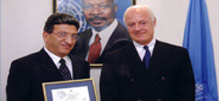Najib Saab, Issue 246, September 2018
In 2000, the late Prime Minister Rafic Hariri invited me to introduce environmental dimensions into his parliamentary elections platform, while the economic and social aspects were assigned to Bassel Fleihan. Upon being appointed Prime Minister following his election victory, Hariri included this environmental program in the cabinet statement, which was consequently approved by parliament in the autumn of that year. This was the first time that a bold and clear environmental policy was introduced into a government program in Lebanon. Implementation was hampered by political disputes.
The environmental crisis in Lebanon is the product of a failing system. The political structure, based on sharing interests among clans, emboldens dealing with resources and public wealth not as a common national property, but as part of fiefdoms shared by influential people in the name of religion. Stone quarries, waste dumps and the privatization of coastal zones and beaches are just a few examples of mixing public interests with private greed. Lebanon might not lack good plans and programs, as much as the political will to implement them. If we go back to the environmental policies adopted by the cabinet two decades ago, we find that the solutions which were valid then are still valid today. When I read again the chapter on environment that I wrote in "Options for Lebanon," the book edited by Nawaf Salam in 2003, I can hardly add anything to the plan recommended.
At the forefront of environmental problems in Lebanon are waste management, pollution of air, water and food, coastal zones, deforestation and poor management of water resources. However, the most serious cross-cutting threat to the environment in Lebanon is the chaotic state of land use. Lebanon is treated as a real estate lot up for sale, governed by sloppy land use rules. This makes it possible to employ political and financial influence to obtain special-tailored interpretations which allow commercial developments in almost any location.
Here we are not talking about remote and uninhabited areas only. Some projects inside congested Beirut are a stark example of environmental crime, committed by investors, politicians and influential people. The organizational chaos is evident in the huge commercial complexes and high-rise towers, which are mushrooming within densely populated residential areas, with no service roads or adequate open spaces provided. This exacerbates the traffic congestion problem and causes increased levels of air pollution, as well as blocking visibility.
Since 1994, dozens of internationally-funded programs have been announced in the field of environment, yet we are no better off today than we were 25 years ago. It is as if we are running out of breath, while not moving from our place. The government's statement of October 2000 was the most serious attempt to approach the environmental challenges at the national level. It committed to developing an environmental plan based on priorities, linking environmental policy to fiscal policy through a mix of taxes and incentives, and promised to establish the National Environment agency, as an environmental scientific research body which provides scientific base for policy options. However, the government's environmental statement remained unfulfilled, and the failure to establish the National Environment Agency led to the continued chaos of haphazard projects and programs without proper planning, coordination and monitoring. Remedies are still limited to band-aid solutions often conducted by amateurs.
Prior to setting detailed environmental policies, national priorities must be defined and, accordingly, economic policies should be adjusted to mitigate the negative impacts on the environment. An assessment of the high cost resulting from neglecting environmental considerations is enough to convince planners to integrate them in government policies. The economic losses caused by environmental degradation outweigh growth rates by several folds.
Taking this into account, a viable environmental program can be developed based on the following basic steps:
- Structuring and empowering the Ministry of Environment and bolstering its departments with competent personnel so as to be able to manage major issues, including: environmental policies and strategic planning, legislation and laws, industry and consumer protection, waste, international relations including treaties, noise pollution and traffic, water and agriculture, chemical and radioactive materials, energy and air, information and awareness. Sustainable development and climate change are tackled as cross-cutting issues.
- Establishing the Supreme Council for the Environment, chaired by the Prime Minister, as a political body tasked with environmental coordination between different ministries and departments, and empowered to make binding decisions.
- Establishing the National Environmental Protection Agency, as a specialized body whose mission is to develop environmental options based on science, as a basis for decision-making. It is necessary to allocate a sufficient budget for this institution to carry out its scientific work in cooperation with the National Council for Scientific Research, universities, private sector and specialized organizations. One of the agency's missions is to coordinate and monitor projects implemented with international funding, and to publish periodic reports on the state of the environment in Lebanon.
This will be accompanied by the development of a viable program that identifies priorities for implementation in collaboration with relevant ministries and departments, including: land use regulation, air quality, clean and renewable energy, water management, agriculture and forestry, integrated waste management, education and environmental awareness.
These are beautiful, noble and achievable goals. The fact is that the challenge today is the same as it was 20 years ago, when the government laid down the foundations of an integrated environmental program, which did not find its way to implementation. Is it possible to achieve an environmental renaissance in the midst of political, economic and social deterioration? Is it too late for a rescue after all the damage caused by negligence and mismanagement?
|




